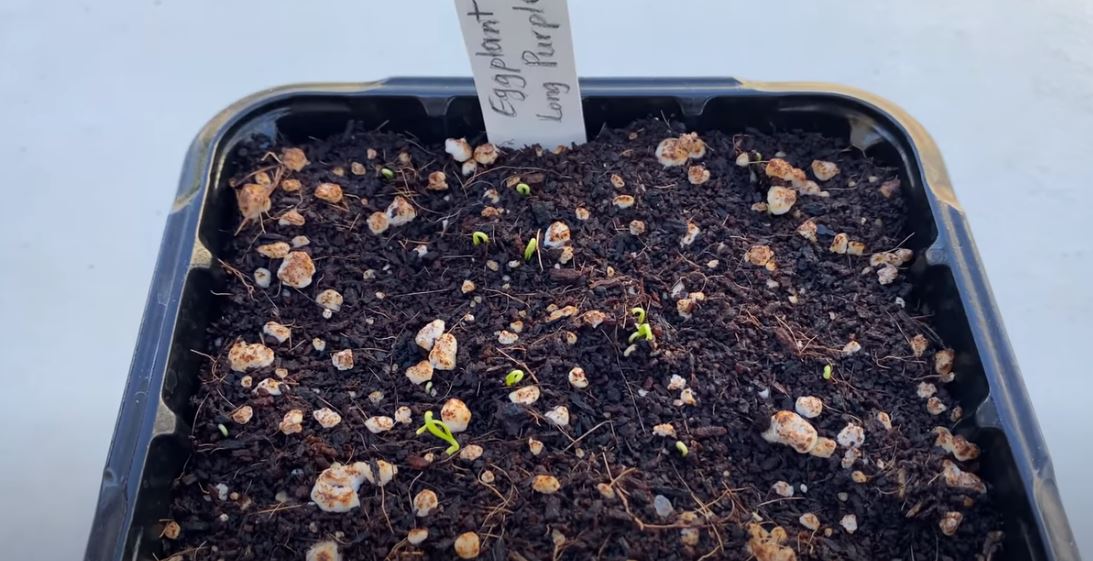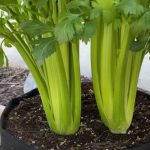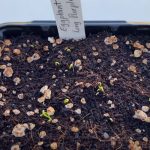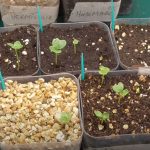Do you need a guide to growing eggplants: from seeds to harvest? You got it! Check out my complete guide to growing eggplants successfully here! Like most vegetables that produce large fruits, eggplants require consistent living conditions and meticulous care. With my instructions, all these requirements are achievable! Check out how to grow this crop from A to Z and how to secure a bountiful yield!
Overview
Level of difficulty: Intermediate. Taking care of eggplants requires more patience than skill.
Nutrition: You can find all kinds of vitamins, minerals, and nutrients in eggplants. This veggie doesn’t contain cholesterol and is extremely low in fat unless you want to roast it with oil because eggplants absorb this component well. Eating eggplants will give you antioxidants to prevent cell damage, control your blood sugar, and support heart health.
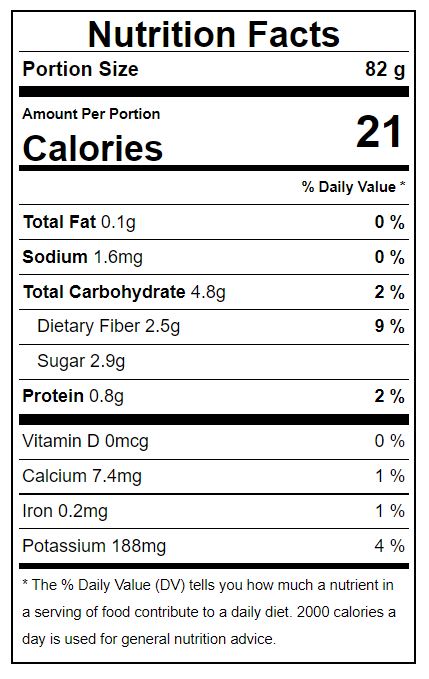
Height: The average height of eggplants is 2 feet, but some varieties can grow up to 3 feet. It’spossible to keep the plant indoors for decorative purposes with that height. But placing the greens outdoors in a sunny site is recommended for the most optimum growth.
Time to fruit: Eggplants take around 2 months to produce fruits, and they are ready for harvesting quite quickly. From seeds to harvest, the crops take a maximum of 120 days, nothing outrageous for a demanding crop that grows such large fruits!
Season to sow: It depends on how you want to start the seeds and the time when the last frost hits your zone. But generally, the best seasons to sow eggplants are late winter and spring. If you germinate eggplant seeds indoors, start indoors 5 to 7 weeks before the last frost. On the contrary, if you want to sow directly outdoors, do it 2 weeks after the last frost.
Lifespan: This species is usually grown annually, and farmers tend to remove them after the first year. But it’s not strange to see eggplants producing large, purple fruits in their second or third year.
Tips For Choosing Eggplant Cultivars

You already know how important it is to choose fresh seeds that are harvested in under 2 years by reliable sources. I find most commercial seeds to have a lower germination rate, and the yield isn’t as impressive as local farmers who purposefully select seeds from an eggplant plant that produces a bountiful yield. This is what you need to do to get good seeds that keep on giving.
Regarding eggplant varieties, consider some of these interesting options:
- Graffiti eggplant: This variety is characterized by its very specific and unique appearance. Along the body of this eggplant, you can find multiple stripes of white and purples merging to create a one-of-a-kind look. Graffito eggplants’ flavor is worth the shot due to its sweetness and lack of bitterness that is usually found in regular eggplants.
- Orient Express: Orient Express eggplants have a long shape and dark purple color, and their flavor is mild with a tinge of bitterness. Each Orient Express eggplant can grow up to 10 inches. How impressive is that?
- Rosa Bianca eggplant: This hybrid is similar to Graffiti eggplant in the sense that they both look like a party of color. Rosa Bianca has a prominent white color that seems to be washed with patches of a purple tone. The fruit has a rounded shape, and the meat texture is tender.
- Vietnamese eggplant: This one is entirely different from the other hybrid as it’s more typically used as pickles. The eggplant has a small and round shape, white color, and a very crunchy texture when salted.
- Santana eggplants: This variety is very large and has a pear shape. If you want impressive-looking eggplant with a soft texture and no stringy bits, Santana eggplant is for you!
Preparation
Tools
- Cell flat tray with a diameter of around 3 inches
- Fertilizer: balanced all-purpose 4-4-4 or nitrogen-rich fertilizer of 21-0-0 or 15-5-10
- Soil blend: sand, loam, organic matter, or compost
- Artificial sun lamp in case there is a light deficit
- Small gardening trowels, rakes, and shovels
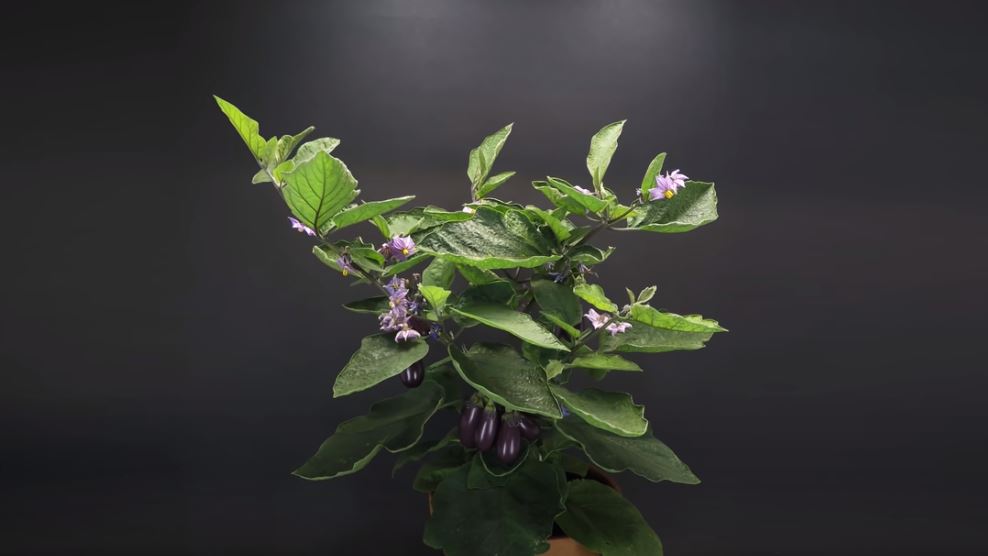
Containers
- Pots that are at least 15 to 20 inches deep and 15 inches wide.
- Raised garden bed with lots of space for the root of eggplant plants to grow sideways, which is quite normal.
A Guide To Growing Eggplants: From Seeds To Harvest
Let’s see what you must do to achieve a successful eggplant crop. Check out my full instructions for growing eggplants from seeds to harvest here!
Germination

Germinating the seeds in the soil is my recommendation. But if you are familiar with the paper towel method and you don’t mind an extra repotting step, you can definitely implement it to guarantee viability. As for the method that involves sowing in soil that I suggest, here are the steps:
Step 1: Prep your cell flat trays and ensure they are clean. Each cell flat in the tray will represent one seed. And there should be drainage holes at the bottom of each cell. The size of the cells should be around 4 inches deep and 3 inches wide.
Step 2: Fill the cells with a well-drained, water-retentive, light soil blend. It should contain lots of organic matter.
Step 3: Create a small hole in each cell that is around 1 to 2 inches deep, and sow the seeds in these holes. Each hole = one seed.
Step 4: Cover the seeds with the same soil and water thoroughly. Make sure that the water sips down slowly to hydrate deeply.
Step 5: Water once every few days when the first inch isn’t damp enough. The viable seeds should grow sprouts after about 7 to 9 days. Some take longer and will break the surface after 10 to 12 days.
Transplanting to containers or garden beds
After 12 to 15 days from sowing, the baby seeds will evolve into young seedlings already. Allow the young sprouts to grow to at least 2 to 3 inches, and consider repotting then. To repot eggplant seedlings, follow these steps:
Step 1: Use a trowel or just your fingers to loosen the dirt around the seedlings. This is very important because we don’t want to pull the seedlings out of the soil at such a young age, and we want to remove the dirt around the roots partially so that they can accustom to the new soil in the new pot or garden bed.
Step 2: Prepare your garden bed or pots with the same soil quality and blend as the one we use for germination. Dig holes deep enough to hold the roots’ length and the base of the stalks.
Step 3: Position the seedlings in their new pots or garden bed and pack the dirt around the main stalks to keep the seedlings straight and secure.
Step 4: Water thoroughly.

Seedlings
Keep up with the watering schedule and start fertilizing 14 days after transplanting the seedlings. After 2 weeks more, the seedlings will have grown into young plants already. Make sure that they receive plenty of suns to grow the foliage.
Hand-pollinating indoor trees/ Outdoor pollination
After 50 to 60 days, your eggplants must be bearing flowers already. These flowers have purple color and both male and female reproductive parts. So, the flowers themselves are self-fertile, and you don’t need to distinguish them for pollination.
But that doesn’t mean that all eggplant flowers are going to grow into fruits. The reason may vary, but one of them is that the roots and foliage focus their nutrients and energy on growing fruits that emerge early. Thus other flowers tend to wilt for not being able to compete with the bigger fellows.
Adult eggplants
After the first fertilization, repeat it once after every 3 or 4 weeks and stop when the eggplants start expanding. You can fertilize as frequently as once every 2 weeks, but we want to avoid burning the roots.
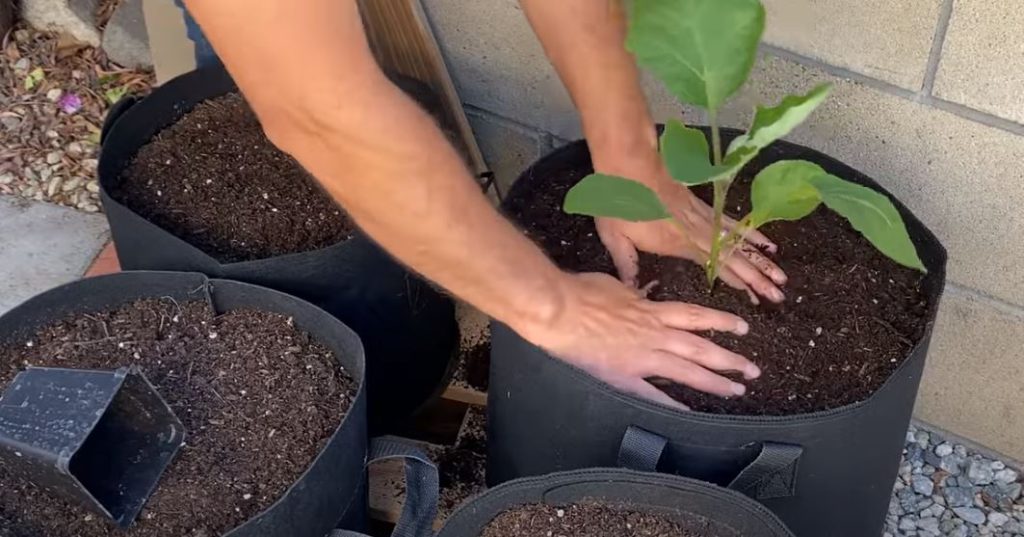
Harvest
Your eggplants are ready to harvest 90 to 120 days after sowing the seeds. You should know the average mature size of the cultivar to have a reference of harvesting time. But the best way to check is to look at the peel’s color and gloss. If the peel looks vivid and quite glossy, even when the purple tone is dark, that’s the ideal time to cut the eggplants by the stems. Don’t let the gloss fade, and the color turns slightly yellow to harvest.
How To Care For Your Eggplant Crops
What do eggplants need to thrive and bear fruits? Learn more about their living conditions here!
Light
Eggplants thrive in full sun, so make sure that the plants receive at least 6 to 8 hours of direct sunlight per day. Since eggplants are quite large fruit, living in partial or full-shade areas will make the plants weak and need to transform more energy to grow the fruits. Furthermore, fungal diseases are more prominent when there isn’t enough sun exposure as well.
In case you grow your eggplants in a pot, place them in a place where they can receive natural sun. The artificial lamps are only good during the first weeks of growth. When the plants have reached maturity and are producing flowers and fruits, the dim-lit artificial sun lamp won’t be enough to provide energy for respiration and sugar metabolism.
Can eggplants get too much sun, though? Yes, when the fruits have already appeared and are getting larger, it can be dangerous for the plants to get intense sunlight. The most common consequences are scalded or cracked eggplants.
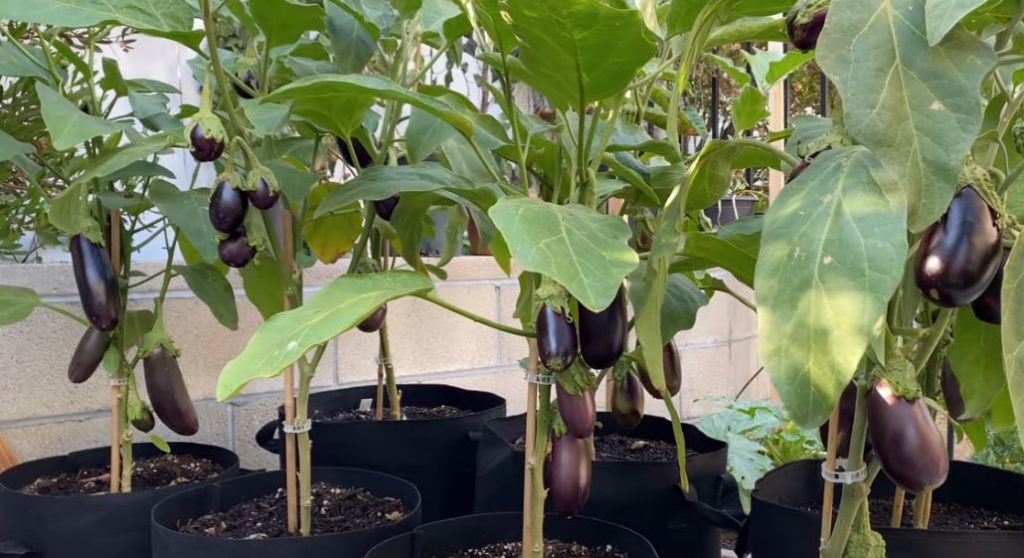
Temperature
Eggplants live very well in tropical climates with hotter summer months, so make sure that the plants don’t have to experience an extended cold period. The optimum temperature range to grow this vegetable is from 70 to 85 degrees F. If the soil temperature drops lower than 50 degrees F, the plants will experience weakened stems, branches, foliage, fruits, etc. A single frost can finish this crop’s life.
But how hot is too hot for eggplants? If the temperature rises over 95 degrees F, don’t be surprised to see the flowers wilt and stop setting fruits. But hey, if you intend to grow the plants as decorative greens, I don’t think allowing no fruit-bearing is a bad idea. Eggplant flowers are lovely!
Water
The best way to water eggplants is to do it infrequently, deeply, and patiently. Some eggplants have deep-running roots, while others manifest shallow sideways growth. In all cases, it’s best to employ slow but deep irrigation to make sure that the water reaches further away from the soil surface.
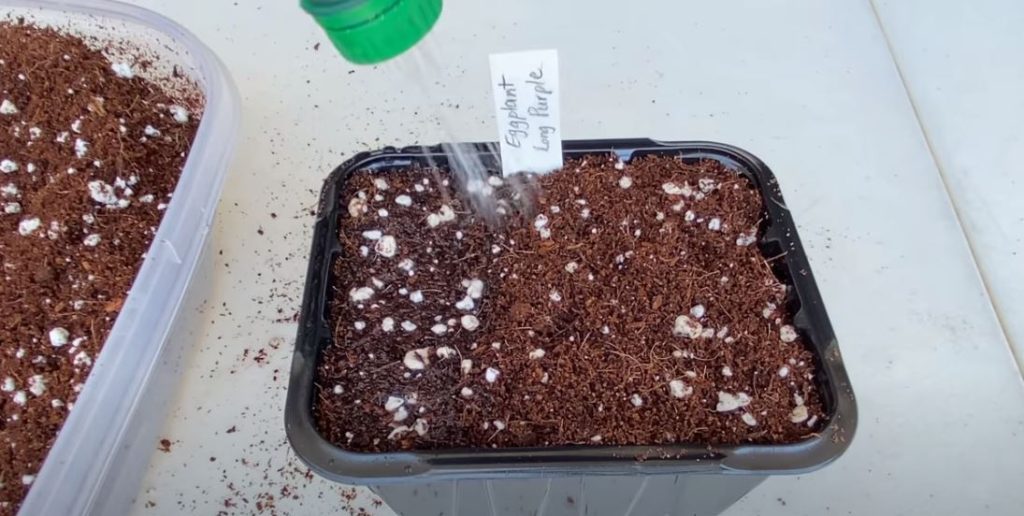
Oxygen
Eggplants love well-drained soil that allows oxygen to reach the root system. That’s why including organic matter or perlite as air pockets is so important for this crop. The roots will eventually die if exploited by air. They won’t be able to transform and transport nutrients to grow the other parts of the plants either. So make sure that the soil is well-drained and avoid overwatering.
Diseases
The major reasons that lead to diseases in eggplants are outrageous or lacking sun exposure, inconsistent watering style and schedule, and untimely intervention when bugs appear.
As I already explained, the species loves the full sun but can’t tolerate too intense exposure paired with high heat during the maturing phase when the fruits are bulging. As for hydration, deep watering is good for hydration, but too much water on mal-drained soil is overkill as bacteria and fungi keep stacking up in such an environment.
You can start using a liquid fungicide to spray the leaves and stems 10 to 14 days after transplanting or as soon as 7 days. This will keep all the troubling diseases at bay!
Fertilizer
You can start using fertilizer 1-2 weeks after transplanting. The best types for eggplant crops are balanced 4-4-4 fertilizer or nitrogen-rich types with an MPK of 21-0-0 or 15-5-10. Side-dress the fertilizer within the 2-3-inch radius and water thoroughly so that it slips into the soil.
Remember that the fertilizer nutrient the soil, and the soil feeds the plants. Don’t distribute fertilizer directly onto the greens themselves, as it can burn the cells.
